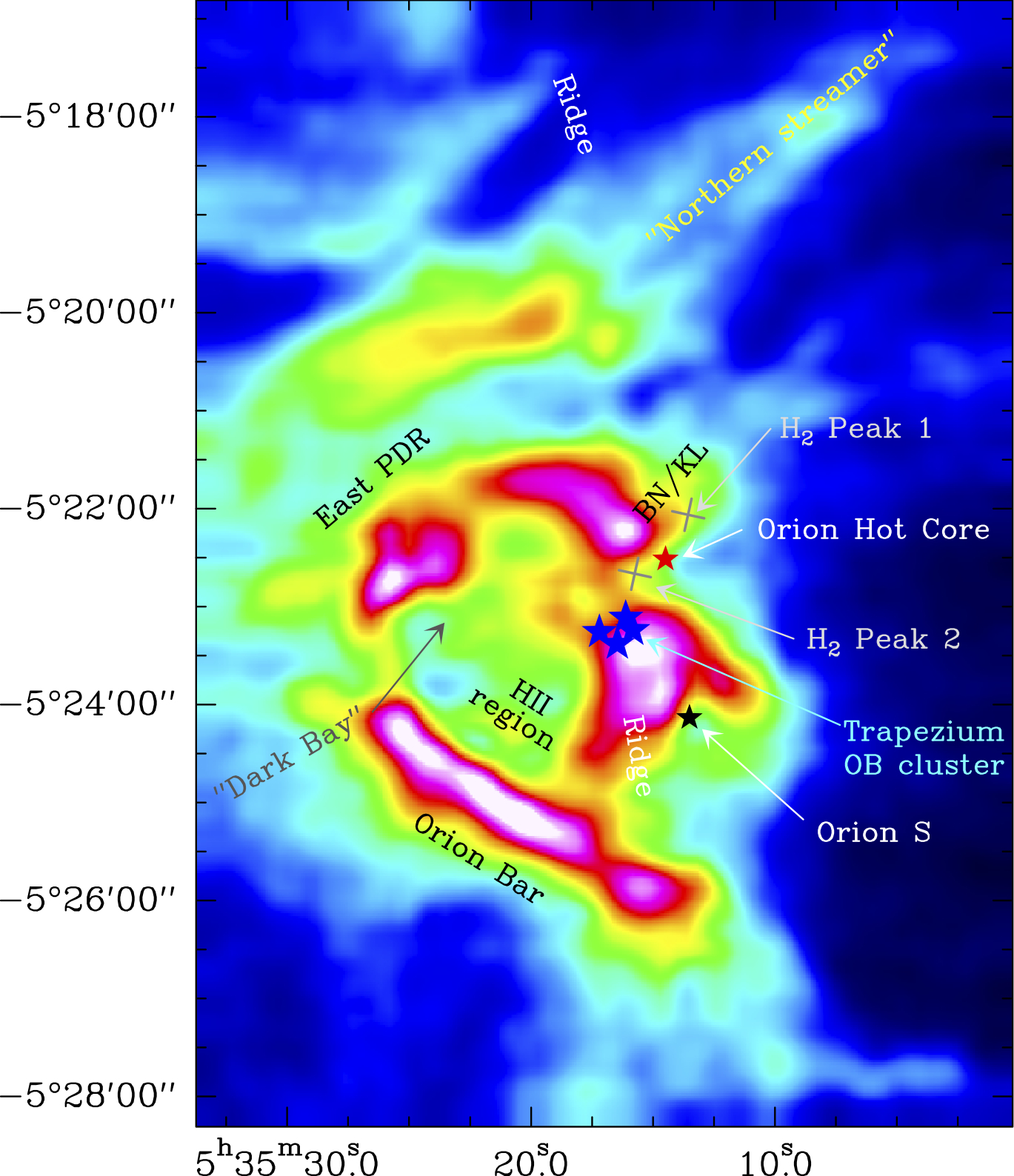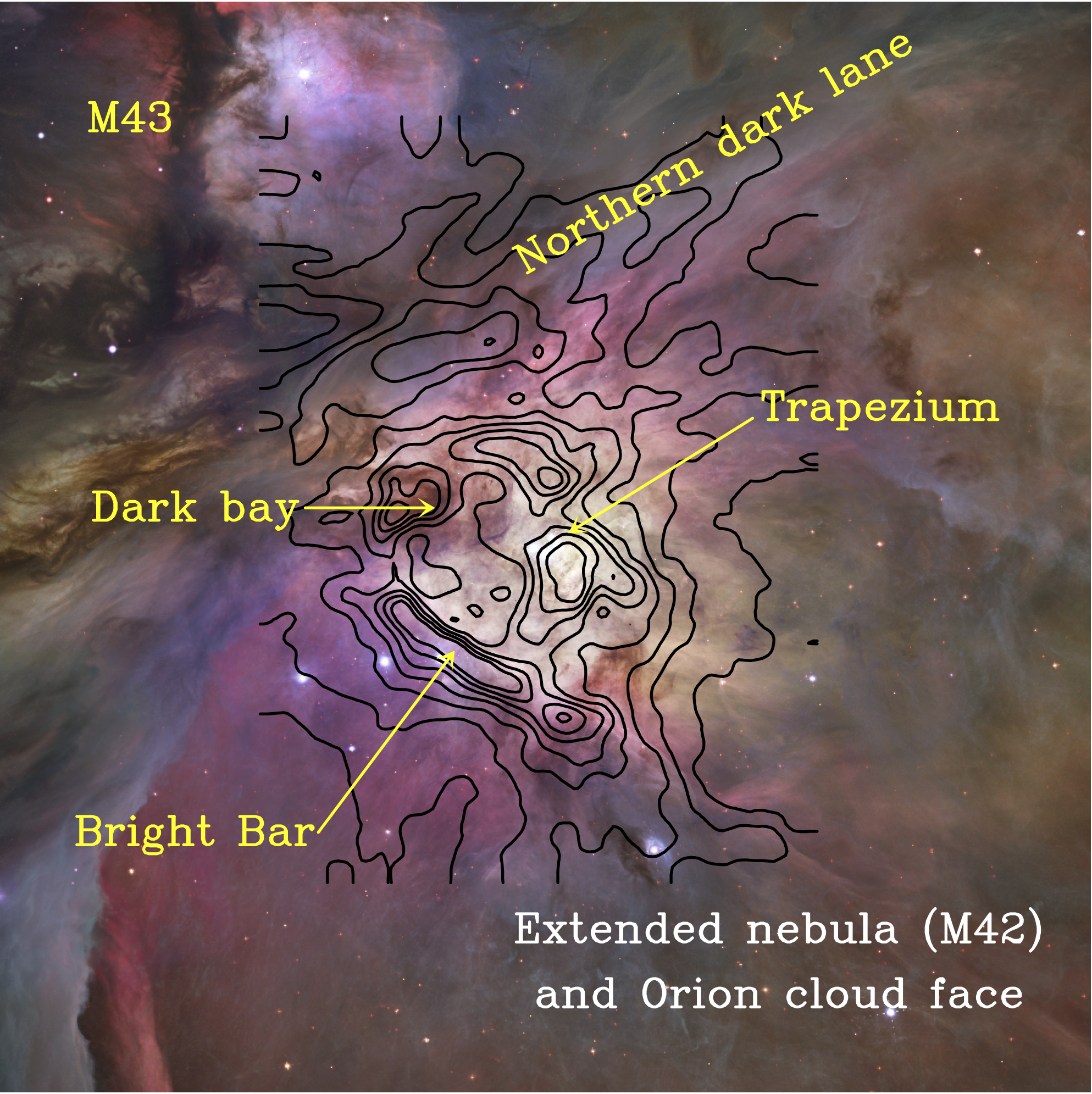The Herschel Space Observatory has revolutionised our understanding of what star forming clouds look like. Photometric images of the dust emission, obtained at far-infrared wavelengths, have revealed spectacular networks of filamentary structures where stars are born. Those newborn massive stars (more massive than 8 solar masses) release large quantities of energy as ionizing UV radiation and as strong winds while they are still surrounded by their parental cloud. Literally, the children grow “eating” the parental medium.

The processes associated with massive star formation disrupt the interstellar environment, and drastically modify and shape the enveloping cloud where stars are born: heating the dust and gas, creating elongated structures or pillars, excavating cavities and producing structures of very different geometries. Nevertheless, while photometric images (of a single colour or wavelength) provide a “snapshot” of the impact of high-mass star formation over entire clouds, it is only by detecting the light emitted from specific gas compounds that we can probe and study the gas dynamics, and the detailed effects that stars have on their parental clouds.
The required technique is called “high-resolution spectroscopy”, and allows splitting the light in exquisite detail (more less splitting a colour in a million parts), up to the point where the emission lines from individual gaseous species can be distinguished. This was a unique capability of HIFI (Heterodyne Instrument for the Far-Infrared), on board Herschel, the largest telescope ever launched to space.

Key element
The neutral carbon atoms present in interstellar clouds are easily ionized by ultraviolet (UV) photons emitted by nearby massive stars. Thus they trace the critical transition from the fully ionized to the neutral interstellar medium where molecules start to form. The carbon ion (C+) produces a very strong emission line in the far infrared [1] that is free of light-obscuration problems (also called extinction or absorption by small dust particles). Thus, being sensitive to the UV radiation, studying the C+ emission, astronomers can indirectly estimate the star formation rate.
In addition, this line is often the brightest emission from star-forming galaxies [2]. The line is so intense that it can be detected in very distant galaxies of the early Universe. It is a true lighthouse that allows us studying star-forming regions and the star-formation rate far from the Milky Way.
ALMA
Paradoxically, while it is difficult from the ground to detect the C+ emission from our Galaxy [3], the line does become accessible to ground-based sub-millimetre observatories such as ALMA (Atacama Large Millimeter-submillimeter Array for much more distant galaxies seen at longer wavelengths, due to the Doppler effect [4].
Indeed, the ionized carbon emission will be the ALMA workhorse line for studies of the primitive Universe. That is, ALMA will be able to detect C+ routinely when the age of the Universe was between 2 and 15 times its present age. Unfortunately, even for the closest galaxies, there are many details of the ionized carbon emission that scientists don’t fully understand.
Perhaps the most important one is the so-called C+ luminosity ”deficit” seen toward nearby ultra-luminous infrared galaxies, very massive objects hosting vigorous star formation and thus characterized by strong UV-radiation fields from newly-formed massive stars. In these “monster” galaxies, the C+ emission only represents a small fraction of the total far infrared dust emission (much less than in “normal” galaxies like the Milky Way). The Orion Molecular Cloud in 3D
Molecular cloud
The Orion molecular cloud 1 (OMC 1) lies behind the Orion Nebula (easily seen in the visible-light images) and is the nearest [5] and probably the most studied high-mass star-forming region of the Milky Way.
The entire region is directly exposed to the strong UV radiation field emitted by young massive stars in the famous Trapezium stellar cluster [6]. Nearby high-mass star-forming regions like Orion, offer a unique laboratory in which to investigate the C+ emission in UV-irradiation conditions that may resemble those in starburst and ultra-luminous infrared galaxies. The UV radiation from the Trapezium stars is eating into the Orion cloud, with the UV-illuminated cloud face, the Orion’s skin, shining in C+ emission.
For the first time, Herschel-HIFI allowed to image the C+ emission in striking detail, obtaining a nearly 3D view of the UV-illuminated face of OMC 1, the Orion’s cloud skin. The resulting images provide an unprecedented view of the intricate small-scale motions of the ionized and of the molecular gas interfaces and of the UV radiation effects on the cloud.
The surprising point of this work is that the physical conditions revealed by the C+ image of Orion, those of a young massive stellar cluster still surrounded by its parental cloud, can dominate and help us to understand the C+ emission at the scales of an entire galaxy (millions of square light-years). While nearly 10h were needed to obtain the carbon ion C+ image of OMC 1 with Herschel-HIFI from space, only a few minutes are needed to detect C+ in very distant galaxies with the 66 antennae of ALMA (due to its much larger collecting area).
This study opens new avenues to better characterize and link the interstellar medium and the star formation process from the Milky Way to the primitive Universe.
More information
The paper Velocity-resolved [CII] emission and [CII]/FIR mapping along Orion with Herschel has been published in The Astrophysical Journal, 9 October 2015. Authors are Javier R. Goicoechea(ICMM?CSIC, Madrid, Spain) and collaborators.
Contact:Javier R. Goicoechea,Grupo de Astrofísica Molecular del Instituto de Ciencia de Materiales de Madrid (ICMM), Consejo Superior de Investigaciones Científicas (CSIC), Spain, email jr.goicoechea@icmm.csic.es.
Notes
[1] The so-called [CII] fine structure line at a wavelength of 158 ?m can be observed with telescopes like Herschel, sensitive to far infrared radiation from interstellar space.
[2] H2, the most abundant interstellar species, radiates very inefficiently.
[3] We need telescopes on board stratospheric aircrafts, balloons or space telescopes that avoid the atmospheric blocking of the radiation in the far infrared coming from space.
[4] At redshifts z>1 (the light shifts to longer wavelengths due to the Doppler Effect redshift produced by the expansion of the Universe).
[5] At ?1500 light years.
[6] The Trapezium cluster, a young and massive cluster partially surrounded by its parental molecular cloud, is located (from the observer point of view) at ?1 light-year in front of the parental molecular cloud.


